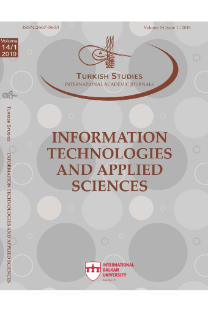Firmaların Endüstri 4.0 Olgunluk Düzeylerinin Tespitine Yönelik Bir Araştırma: Sivas İli Örneği
A Research on Determination of the Companies' Industrial 4.0 Maturity Levels: Case of Sivas Province
___
- Akdil, K. Y., Ustundag, A., & Cevikcan, E. (2018). Maturity and readiness model for industry 4.0 strategy. In Industry 4.0: Managing the digital transformation (pp. 61-94). Springer, Cham.
- Alguliyev, R., Imamverdiyev, Y., & Sukhostat, L. (2018). Cyber-physical systems and their security issues. Computers in Industry, 100, 212-223.
- Bahrin, M. A. K., Othman, M. F., Azli, N. N., & Talib, M. F. (2016). Industry 4.0: A review on industrial automation and robotic. Jurnal Teknologi, 78(6-13), 137-143.
- Ceruti, A., Marzocca, P., Liverani, A., & Bil, C. (2019). Maintenance in aeronautics in an Industry 4.0 context: The role of Augmented Reality and Additive Manufacturing. Journal of Computational Design and Engineering, 6(4), 516-526.
- De Bruin, T., Freeze, R., Kaulkarni, U., & Rosemann, M. (2005). Understanding the main phases of developing a maturity assessment model.
- Ding, D., Han, Q. L., Xiang, Y., Ge, X., & Zhang, X. M. (2018). A survey on security control and attack detection for industrial cyber-physical systems. Neurocomputing, 275, 1674-1683.
- Frank, A. G., Dalenogare, L. S., & Ayala, N. F. (2019). Industry 4.0 technologies: Implementation patterns in manufacturing companies. International Journal of Production Economics, 210, 15-26.
- Geissbauer, R., Vedso, J., & Schrauf, S. (2016). Industry 4.0: Building the digital enterprise. Retrieved from PwC Website: https://www. pwc. com/gx/en/industries/industries-4.0/landing-page/industry-4.0-building-your-digital enterprise-april-2016.pdf.
- https://www.crimsonandco.com/wp-content/uploads/2017/10/Industry-4-readiness-assessment tool-report-Oct-2017.pdf, erişim tarihi: 12 Şubat 2020
- https://www.dijitalakademi.gov.tr/dijital-olgunluk, erişim tarihi: 12 Şubat 2020
- ITU (2015). ITU-TX.1205: series X: data networks, open system communications and security: telecommunication security: overview of cybersecurity
- ITU (2012). Series y: Global information infrastructure, internet protocol aspects and next generation networks next generation networks–frameworks and functional architecture models. International Telecommunication Union, Geneva, Switzerland, Recommendation ITU-T Y, 2060.
- Khoshgoftar, M., & Osman, O. (2009, August). Comparison of maturity models. In 2009 2nd IEEE International Conference on Computer Science and Information Technology (pp. 297-301). IEEE.
- Lichtblau, K., Stich, V., Bertenrath, R., Blum, M., Bleider, M., Millack, A., ... & Schröter, M. (2015). IMPULS-industrie 4.0-readiness. Impuls-Stiftung des VDMA, Aachen-Köln.
- Manyıka, James, et al. Big data: The next frontier for innovation, competition. and productivity. Technical report, McKinsey Global Institute, 2011.
- Mell, P., & Grance, T. (2011). The NIST definition of cloud computing.
- Rockwellautomation: The Connected Enterprise Maturity Model. 12 (2014).
- Rüßmann, M., Lorenz, M., Gerbert, P., Waldner, M., Justus, J., Engel, P., & Harnisch, M. (2015). Industry 4.0: The future of productivity and growth in manufacturing industries. Boston Consulting Group, 9(1), 54-89.
- Schuh, G., Anderl, R., Gausemeier, J., ten Hompel, M., & Wahlster, W. (2017). Industrie 4.0 maturity index. Managing the digital transformation of companies. Munich: Herbert Utz.
- Schumacher, A., Erol, S., & Sihn, W. (2016). A maturity model for assessing Industry 4.0 readiness and maturity of manufacturing enterprises. Procedia Cirp, 52(1), 161-166.
- Scremin, L., Armellini, F., Brun, A., Solar-Pelletier, L., & Beaudry, C. (2018). Towards a framework for assessing the maturity of manufacturing companies in Industry 4.0 adoption. In Analyzing the Impacts of Industry 4.0 in Modern Business Environments (pp. 224-254). IGI Global.
- Shafranek, R. T., Millik, S. C., Smith, P. T., Lee, C. U., Boydston, A. J., & Nelson, A. (2019). Stimuli-responsive materials in additive manufacturing. Progress in Polymer Science.
- Sung, T. K. (2018). Industry 4.0: a Korea perspective. Technological forecasting and social change, 132, 40-45.
- Schwab, K. (2016). The fourth industrial revolution, Mega-study Corporation, Seoul.
- Zhu, W., Owen, C. B., Li, H., & Lee, J. H. (2004). Personalized in-store e-commerce with the promopad: an augmented reality shopping assistant. Electronic Journal for E-commerce Tools and Applications, 1(3), 1-19.
- ISSN: 2667-5633
- Yayın Aralığı: 4
- Başlangıç: 2006
- Yayıncı: ASOS Eğitim Bilişim Danışmanlık Otomasyon Yayıncılık Reklam Sanayi ve Ticaret LTD ŞTİ
Tedarik Zinciri Yönetiminde Bilgi Teknolojilerinin Önemi - Gıda Firma Uygulaması
Ahmet Alper SAYIN, Refik DEMİREL
Üstün Yetenekeli Öğrencilerin Oyun Tasarımı ve Kodlama Eğitimi Programları Hakkında Görüşleri
Makine Öğrenme Algoritmaları ile Karaciğer Hastalığının Teşhisi
Aytürk KELEŞ, Özden Burcu KARSLI, Ali KELEŞ
Introduction and Benchmark Result Comparison of Social-Inspired Algorithms
Ayşenur DALMIŞ, Fatih V. ÇELEBİ
Sosyo-İlham Algoritmalarına Giriş ve Kıyaslama Sonuçlarının Karşılaştırılması
Ayşenur DALMIŞ, Fatih V. Çelebi
Firmaların Endüstri 4.0 Olgunluk Düzeylerinin Tespitine Yönelik Bir Araştırma: Sivas İli Örneği
Ali Rıza İNCE, Mehmet Zahit ŞİMŞEK
İnternet Haber Sitelerinin Kullanılabilirliğinin Göz İzleme Teknikeriyle Analizi
Adaptation of Design Self-Efficacy Scale into Turkish Language
